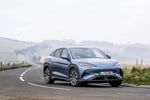Review
Super strength batteries could soon be turning electric motors into the major driving force in upmarket mobility.
Boasting double the capacity of present storage cells, they will power future plug-in hybrid cars for more than 60 miles between charges and relegate traditional engines to a relatively minor role in business and pleasure transport.
BMW engineers believe next-generation electric drivetrain technology is set to produce hybrid systems developing up to 500 kW - enough to allow virtually all day-to-day driving to be completed in zero-emission mode.
“Our view is that unrestricted everyday practicality will make this the natural choice with a traditional combustion engine accounting for only one third of power to provide a boost in output when required and help increase the driving range to levels of conventional vehicles,” development manager Helmuth Wiesler told Fleet News.
He was speaking as a prototype of BMW's first production plug-in hybrid saloon was revealed to the media in France.
Due to be available in 2016, this version of the 3 Series mates a 95hp electric motor with its two-litre, four-cylinder twin turbo engine to promise a 155mph top speed, 140mpg average operating economy, a 22-mile electric-drive range at speeds up to 75mph and tailpipe emissions of 50g/km.
“What we're talking about here is sporty performance on a par with a conventional six-cylinder 3 Series along with a significant drop in fuel consumption. And this is just the start: we aim to increase the efficiency and dynamism of hybrids backed by batteries of up to 20 kilowatt hours capacity – greatly in excess of current systems,” said Wiesler.
The eDrive 3 looks much like the standard car but has slightly stronger suspension to compensate for a 165kg battery pack mounted at the rear. Slung under the floor, it encroaches the boot by only 35mm to make little practical difference in luggage capacity.
The extra weight also has little effect on the car's handling balance and with an eight-speed automatic transmission channelling power to the rear wheels, the hybrid is just as confident and secure as other versions when pushed hard through bends.
Acceleration is rapid and hushed and a console switch offers comfort, sport and eco pro settings for suspension and transmission. Another button provides zero-emission travel and a 'save' feature enables charge to be held ready for use when all-electric drive is required.
In Comfort, the default operating mode, system control strategy is based on fuel efficiency with the engine cutting in seamlessly to provide extra power. In Eco Pro mode, air conditioning, seat heating and even door mirror heating are all reduced to help boost electric drive range - but in Sport, both power sources remain on stream at all times for maximum response and it's then that the battery range indicator reverts to its traditional role as a rev counter.
BMW's satnav system has also been adapted to eke out battery power – it makes real-time information available to help the powertrain controller best match electric drive requirements to the route.
















